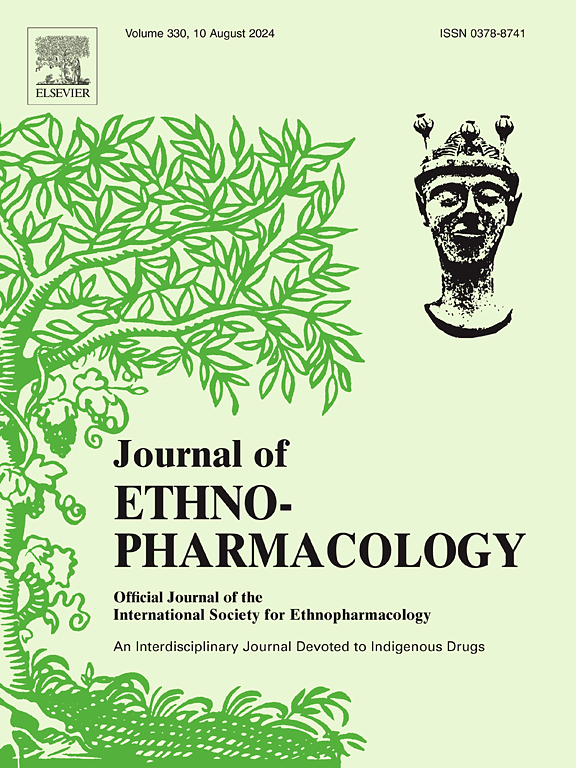Taraxacum mongolicum total triterpenoids and taraxasterol ameliorate benign prostatic hyperplasia by inhibiting androgen levels, inflammatory responses, and epithelial-mesenchymal transition via the TGFβ1/Smad signalling pathway
IF 4.8
2区 医学
Q1 CHEMISTRY, MEDICINAL
引用次数: 0
Abstract
Ethnopharmacological relevance
Taraxacum mongolicum Hand.-Mazz. is a well-known plant used both medicinally and as food, commonly used in traditional Chinese medicine prescriptions to alleviate benign prostatic hyperplasia (BPH). However, the material basis and molecular mechanisms of T. mongolicum alone in improving BPH remain unclear. In recent years, triterpenoids have been considered to be a key chemical constituents for T. mongolicum to exert its biological activity.
Aim of the study
To explore the therapeutic efficacy and underlying mechanism of total triterpenoids from T. mongolicum (TTM) and its active constituents against BPH.
Materials and methods
The chemical components of TTM were determined using UPLC-QTOF-MS analysis. We established a testosterone propionate (TP)-induced rat model of BPH to assess the potential of TTM in vivo. Subsequently, network pharmacology was combined with experimental results from a TGFβ1-stimulated BPH-1 cell model to reveal the molecular mechanism of TTM. The main active ingredient (taraxasterol, TAR) of TTM was screened by evaluating its antiproliferative ability against BPH-1 and WPMY cells. Eventually, RNA-sequencing, RT-qPCR, immunofluorescence, and Western blotting were employed to elucidate the potential molecular targets and signalling pathways of TAR in BPH rats.
Results
TTM was mainly composed of ten pentacyclic triterpenoids and one phytosterol, including TAR, lupeol, β-amyrin, taraxerol, and their acetates. TTM ameliorated TP-induced BPH by decreasing androgen levels and repressing inflammatory responses and oxidative stress. Furthermore, TTM inhibited epithelial-mesenchymal transition (EMT) and extracellular matrix (ECM) deposition via impeding the TGFβ1/Smad signalling pathway in BPH-1 cells based on the network pharmacology. Among the main chemical components of TTM, TAR exerted the strongest antiproliferative activity in vitro, and inhibited the growth of BPH-1 and WPMY-1 cells in a concentration dependent manner. Importantly, TAR also reduced androgen levels and inflammatory responses to balance proliferation and apoptosis in BPH rats. Transcriptomic analysis showed that TAR attenuated collagen deposition in BPH by inhibiting ECM-receptor interaction pathway. In addition, TAR notably suppressed EMT and the TGFβ1/Smad signalling in BPH rats, as evidenced by reduced the protein levels of collagen I, a-SMA, Snail, TGFβ1, p-Smad2/Smad2, and p-Smad3/Smad3, alongside an increase in E-cadherin expression.
Conclusions
TTM or TAR could effectively improve TP-induced BPH by suppressing androgen levels, inflammatory response, and EMT via the TGFβ1/Smad signalling pathway. These findings may present new therapeutic approachs for BPH in clinical settings. Notably, this study is the first to systematically elucidate the therapeutic mechanism of triterpenoids from T. mongolicum in treating BPH.
蒙古蒲公英总三萜和蒲公英甾醇通过tgf - β1/Smad信号通路抑制雄激素水平、炎症反应和上皮-间质转化,改善良性前列腺增生。
民族药理学相关性:蒙古蒲公英。是一种著名的药用和食用植物,常用于缓解良性前列腺增生(BPH)的中药处方中。然而,单药改善BPH的物质基础和分子机制尚不清楚。近年来,三萜类化合物被认为是蒙古毛霉发挥其生物活性的关键化学成分。目的:探讨蒙古赤霉素(T. mongolicum, TTM)总三萜及其有效成分对BPH的治疗作用及其机制。材料和方法:采用UPLC-QTOF-MS分析方法测定其化学成分。我们建立了丙酸睾酮(TP)诱导的BPH大鼠模型,以评估TTM在体内的潜力。随后,网络药理学结合tgf β1刺激BPH-1细胞模型的实验结果,揭示TTM的分子机制。通过评价其对BPH-1和WPMY细胞的抗增殖能力,筛选其主要活性成分taraxasterol (TAR)。最终通过rna测序、RT-qPCR、免疫荧光和Western blotting等方法,阐明了BPH大鼠中TAR的潜在分子靶点和信号通路。结果:TTM主要由10种五环三萜和1种植物甾醇组成,包括TAR、luppeol、β-amyrin、taraxerol及其乙酸酯。TTM通过降低雄激素水平和抑制炎症反应和氧化应激来改善tp诱导的BPH。此外,基于网络药理学,TTM通过阻断BPH-1细胞中tgf - β1/Smad信号通路,抑制上皮-间质转化(EMT)和细胞外基质(ECM)沉积。在TTM的主要化学成分中,TAR的体外抗增殖活性最强,对BPH-1和WPMY-1细胞的生长具有浓度依赖性。重要的是,TAR还降低了BPH大鼠的雄激素水平和炎症反应,以平衡增殖和凋亡。转录组学分析表明,TAR通过抑制ecm -受体相互作用途径减轻BPH中胶原沉积。此外,TAR显著抑制BPH大鼠的EMT和TGFβ1/Smad信号传导,这可以通过降低胶原I、a-SMA、Snail、TGFβ1、p-Smad2/Smad2和p-Smad3/Smad3蛋白水平以及增加E-cadherin表达来证明。结论:TTM或TAR可通过tgf - β1/Smad信号通路抑制雄激素水平、炎症反应和EMT,有效改善tp诱导的BPH。这些发现可能为BPH的临床治疗提供新的方法。值得注意的是,本研究首次系统地阐明了蒙古赤霉素三萜治疗BPH的作用机制。
本文章由计算机程序翻译,如有差异,请以英文原文为准。
求助全文
约1分钟内获得全文
求助全文
来源期刊

Journal of ethnopharmacology
医学-全科医学与补充医学
CiteScore
10.30
自引率
5.60%
发文量
967
审稿时长
77 days
期刊介绍:
The Journal of Ethnopharmacology is dedicated to the exchange of information and understandings about people''s use of plants, fungi, animals, microorganisms and minerals and their biological and pharmacological effects based on the principles established through international conventions. Early people confronted with illness and disease, discovered a wealth of useful therapeutic agents in the plant and animal kingdoms. The empirical knowledge of these medicinal substances and their toxic potential was passed on by oral tradition and sometimes recorded in herbals and other texts on materia medica. Many valuable drugs of today (e.g., atropine, ephedrine, tubocurarine, digoxin, reserpine) came into use through the study of indigenous remedies. Chemists continue to use plant-derived drugs (e.g., morphine, taxol, physostigmine, quinidine, emetine) as prototypes in their attempts to develop more effective and less toxic medicinals.
 求助内容:
求助内容: 应助结果提醒方式:
应助结果提醒方式:


